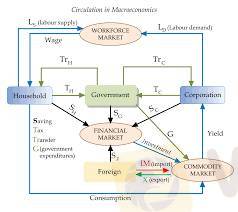
2025-02-06 09:34
業界Macroeconomics theory
#firstdealofthenewyearastylz
Macroeconomics is a branch of economics that studies the behavior and performance of an economy as a whole. It focuses on aggregate changes and the overall functioning of the economy, rather than individual markets. Here are the key components and theories of macroeconomics:
1. Aggregate Demand and Supply: Macroeconomics analyzes the total demand (aggregate demand) and total supply (aggregate supply) in an economy. Aggregate demand is the total quantity of goods and services demanded across all levels of the economy at a given overall price level, while aggregate supply is the total production of goods and services at a given price level.
2. National Income Accounting: This involves measuring a country's economic performance through indicators like Gross Domestic Product (GDP), Gross National Product (GNP), and Net National Product (NNP). GDP measures the total value of all goods and services produced over a specific time period within a country.
3. Business Cycles: Macroeconomics studies the fluctuations in economic activity over time, known as business cycles. These cycles consist of periods of expansion (growth) and contraction (recession) and are influenced by various factors including consumer confidence, investment, and government policies.
4. Monetary Policy: This refers to the actions taken by a country's central bank to control the money supply and interest rates to achieve macroeconomic objectives such as controlling inflation, consumption, growth, and liquidity. Tools include open market operations, discount rates, and reserve requirements.
5. Fiscal Policy: This involves government spending and taxation policies to influence economic conditions. By adjusting spending levels and tax rates, governments can impact overall economic activity, aggregate demand, and employment levels.
6. Inflation and Unemployment: Macroeconomics examines the relationship between inflation (the rate at which the general level of prices for goods and services rises) and unemployment (the percentage of the labor force that is jobless). The Phillips Curve illustrates this trade-off, suggesting that lower unemployment can lead to higher inflation.
7. Economic Growth: This aspect focuses on the long-term increase in a country's productive capacity, often measured by GDP growth. Factors that contribute to economic growth include technological advancements, capital accumulation, and improvements in labor productivity.
8. International Economics: Macroeconomics also considers how economies interact on a global scale, including trade balances, exchange rates, and the impact of international policies on domestic economies.
Overall, macroeconomic theory provides a framework for understanding how economies operate and how various factors influence economic performance. It helps policymakers design strategies to promote economic stability and growth.
My AI currently does not provide accurate information for events that occurred after December 2023. Please check other reliable sources for more up-to-date information.
いいね 0

Monix
Corretoras
人気の話題
業界
米国株式や日経などのクロスボーダー ETF は大量に高値で償還され
業界
包括的なリスク管理計画を策定する
業界
高度なテクノロジーとテクニカル分析を活用する
業界
📢2025年1月9日11:00の通貨ペア
業界
危険】:米国でVarna Tradeを訪問しましたが、オフィスは見つかりませんでした‼ 詳細は下の画
業界
👀#WikiFX 「先週、日本人ユーザーが最も検索されたFX会社が発表されました!」
市場分類

会社ナビ

エキスポ

IB

募集

EA

業界

相場

指標
Macroeconomics theory
 香港 | 2025-02-06 09:34
香港 | 2025-02-06 09:34#firstdealofthenewyearastylz
Macroeconomics is a branch of economics that studies the behavior and performance of an economy as a whole. It focuses on aggregate changes and the overall functioning of the economy, rather than individual markets. Here are the key components and theories of macroeconomics:
1. Aggregate Demand and Supply: Macroeconomics analyzes the total demand (aggregate demand) and total supply (aggregate supply) in an economy. Aggregate demand is the total quantity of goods and services demanded across all levels of the economy at a given overall price level, while aggregate supply is the total production of goods and services at a given price level.
2. National Income Accounting: This involves measuring a country's economic performance through indicators like Gross Domestic Product (GDP), Gross National Product (GNP), and Net National Product (NNP). GDP measures the total value of all goods and services produced over a specific time period within a country.
3. Business Cycles: Macroeconomics studies the fluctuations in economic activity over time, known as business cycles. These cycles consist of periods of expansion (growth) and contraction (recession) and are influenced by various factors including consumer confidence, investment, and government policies.
4. Monetary Policy: This refers to the actions taken by a country's central bank to control the money supply and interest rates to achieve macroeconomic objectives such as controlling inflation, consumption, growth, and liquidity. Tools include open market operations, discount rates, and reserve requirements.
5. Fiscal Policy: This involves government spending and taxation policies to influence economic conditions. By adjusting spending levels and tax rates, governments can impact overall economic activity, aggregate demand, and employment levels.
6. Inflation and Unemployment: Macroeconomics examines the relationship between inflation (the rate at which the general level of prices for goods and services rises) and unemployment (the percentage of the labor force that is jobless). The Phillips Curve illustrates this trade-off, suggesting that lower unemployment can lead to higher inflation.
7. Economic Growth: This aspect focuses on the long-term increase in a country's productive capacity, often measured by GDP growth. Factors that contribute to economic growth include technological advancements, capital accumulation, and improvements in labor productivity.
8. International Economics: Macroeconomics also considers how economies interact on a global scale, including trade balances, exchange rates, and the impact of international policies on domestic economies.
Overall, macroeconomic theory provides a framework for understanding how economies operate and how various factors influence economic performance. It helps policymakers design strategies to promote economic stability and growth.
My AI currently does not provide accurate information for events that occurred after December 2023. Please check other reliable sources for more up-to-date information.
いいね 0
私もコメントします
質問します
0コメント件数

誰もまだコメントしていません、すぐにコメントします

質問します
誰もまだコメントしていません、すぐにコメントします